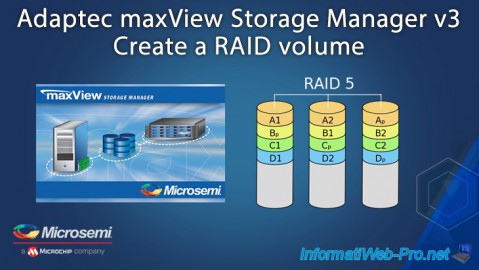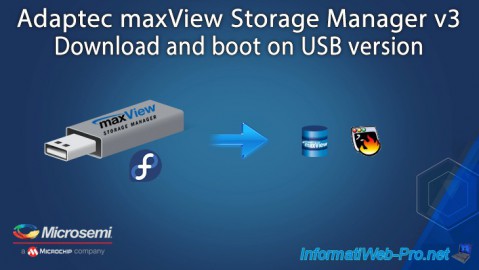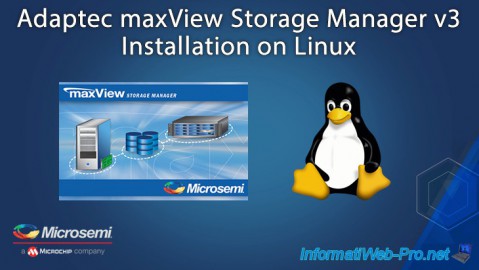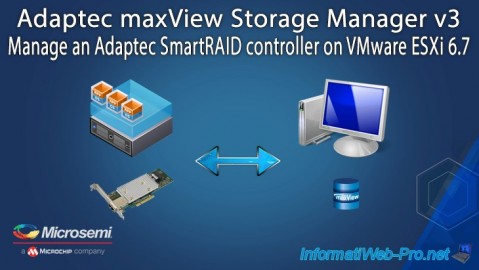Presentation of the Microsemi Adaptec maxView Storage Manager v4 / v3 web interface
- RAID
- 19 May 2024 at 15:34 UTC
-

- 3/5
3.8. Information about a logical device
In the "Summary" tab of the selected logical device, you will find :
- ID : the ID of this logical drive
- RAID Level : the RAID level selected when creating it. For example : RAID 5.
- Device Type : Data for storage and MaxCache for a device used only as a cache.
- Interface Type : the connection interface used on hard drives connected to your Microsemi controller. Ex : SAS or SATA.
- Data Space : storage space available on this logical drive. Therefore, the size indicated doesn't count the space used by the parity.
It's therefore normal that we have a logical device of about 8 TB with 3 hard drives marketed with a capacity of 4 TB. - Stripe Size : size of each stripe on each physical disk (HDD / SSD). Amount of data that can be written to a stripe before moving to the next physical disk in the array.
- Full Stripe Size : combined stripe size of different hard drives regardless of the one used for parity.
Since we have a RAID 5 on 3 hard drives, only 2 hard drives are used for storage. So this combined size is 2 times the stripe size. So : 2 x 256 KB = 512 KB. - Member Device(s) Block Size : maximum size of data blocks on hard drives that are RAID members of this logical device
- Volume Unique Identifier : the unique identifier of this logical device
- Heads, Sectors Per Track and Cylinders : number of heads, sectors and cylinders available on this disk. Refers to CHS addressing used a very long time ago.
For the settings and status of the logical device, you will find :
- Status : his status
- Parity Initialization Status : the parity initialization status for this logical device.
In our case, we created this logical device recently, so the initialization of its parity is still in progress in the background. - Name : the name of the logical device which allows you to find it in maxView or in the configuration utility of your Microsemi SmartRAID controller
- Disk Name : the system name of this logical drive. In our case : \\.\PhysicalDrive2 (Disk2) (Bus: 0, Target: 1, Lun: 0).
- OS Location : the location of the operating system. (If supported.)
- Mounted : indicates whether the logical device is mounted (available) and its mount point (if applicable)
- Controller Caching : indicates whether the cache is preserved in the event of a power problem or not
- Acceleration Method : indicates whether the controller cache is enabled (Controller Cache) for this logical device or not (None)
- Boot Type : a controller can have up to 2 bootable disks. If a logical drive is configured as bootable, the computer / server will attempt to boot from the primary logical device and if this fails, it will attempt to boot from the one configured as secondary logical device.
- Protected by Hot Spare : indicates whether this logical device is protected by a Hot Spare. A Spare is used to automatically rebuild the missing physical disk when one of the physical hard disks affected by this logical device fails.
- information about the maxCache feature and in particular its status (maxCache - State), as well as the status of the policy for the write cache via maxCache.
For the "Resources" section, you will find :
- Task Name / Task Percentage : the current task (if applicable) and its progress
- maxCache Device : disks assigned as cache (if applicable)
- Hot Spare Drive(s) : disks assigned as hot spare (if applicable)
- Member Device(s) : the list of hard drives that are members of this logical device with their location (connector number on the controller + cable number), their status (eg : Optimal) and their size

Since version 4 of maxView Storage Manager, the information displayed for your RAID logical drives has changed slightly.
Indeed, the information for "maxCache" has simply moved places. They are now displayed in the right column instead of the middle one.
However, the list of maxCache devices and the disks assigned as Hot Spare for this RAID logical disk are no longer displayed in this tab.
To see them, simply go to the "Resources" tab of that RAID logical drive.

If we click on the orange icon next to the "Background Parity Initialization" task, we can see the complete information about this task.

In the "Resources" tab of the selected logical device, you will be able to see :
- the list of physical hard disks affected by it, as well as their state, their interface (SAS / SATA), the block size used and the total size of each physical disk
- the logical device partition table

In the "Events" tab, you will find the list of events for the selected logical device.

3.9. Information about the physical hard drives connected to your Microsemi controller
In "Physical Devices", you will find the list of physical hard drives and SSDs connected to your controller with :
- Connector : the number of the connector to which each physical disk is plugged.
WARNING : the number (ID) indicated here corresponds to the X of the "Connector x" value displayed on the left and not to the normal name of the "CNX" connector physically indicated on the controller.
Indeed, as you can see in the image below, maxView indicates that our 3 hard drives are connected to the "CN0" connector, while it's indicated "Connector 0 (CN4)" in the left column - Enclosure ID : Direct Attached indicates that the hard drives are inside the computer / server and/or that these are directly plugged into the Microsemi controller.
- Device/Slot ID : is the number on the cable on the side of the physical-drive connector (SAS / SATA). This number makes it possible to physically find a specific physical disk.
- State : physical disk state.
- Interface : physical disk connection interface. Ex : SAS or SATA.
- Block Size : size of blocks used on this physical disk
- Total Size : total size (capacity) of the physical disk
- Model : model of the physical disk. In our case "HUS726T4TAL5204", which corresponds to the reference of our "WD Ultrastar DC HC310 (4 TB)" hard drives.

By selecting a connector, you will be able to find out :
- ID : ID 0 to X
- Name : its name as it's physically indicated on the Microsemi controller. For example : CN4.
- SAS Address : the SAS address associated with this connector
- Functional Mode : the functional mode for that port. For example : RAID or HBA.
- Location : indicates whether it's an internal or external port
- Number of Device(s) : the number of devices (hard disks and/or SSDs) connected to this port

Using the cable adapted to your case (connector format on the controller and types of hard drives you want to connect to it), you can connect several hard drives (SAS or SATA) and/or SSDs (SATA).
On one side, you have the mini mini SAS HD connector which is plugged into the connector of the controller and on the other side, you have cables to plug in each physical disk (HDD / SSD). These cables are referenced as "Slot X" in maxView.
By selecting a "Slot" in the left column, you will therefore obtain information about the physical disk connected via this cable.
In the "Summary" tab, you will obtain information about the physical disk (Physical Device Info) connected to the selected "Slot" :
- Vendor : the manufacturer of the hard drive or SSD. In our case : HGST. This corresponds to the company "Hitachi Global Storage Technologies" which is a subsidiary of Western Digital (WD / WDC)
- Model : model of the physical disk. In our case : HUS726T4TAL5204. This corresponds to the "WD Ultrastar DC HC310 (4 TB)" hard drive.
- Serial Number : serial number of the physical disk. Interesting if you need to contact the manufacturer of that hard drive or SSD in case of failure, for example.
- Interface Type : type of interface used by this physical disk. In our case "Serial Attached SCSI" which is the meaning of "SAS".
- Total Size : actual physical disk size (capacity)
- Block Size : block size used on this physical disk
- Physical Block Size : is the unit of data that can be physically read or written to the physical disk
- Rotational Speed : speed of rotation (of the platters) of the hard disk. In our case : 7200 RPM.
- Device Type : type of device, such as : HDD (hard disk drive), SSD (Solid-state drive), ...
- Firmware Level : revision number of the physical disk affected by this "Slot"
- WWN : unique identifier (World Wide Name) of the physical disk defined by its manufacturer
- Unique ID : identifier to uniquely identify this physical disk
- Reported Channel : channel on which the physical disk is connected
- Reported SCSI Device ID : the SCSI ID reported by the controller for this physical disk
- NCQ Supported : indicates whether the physical disk supports NCQ (Native Command Queuing) which is a technique allowing a physical disk to receive several requests simultaneously and to choose which requests to process in priority to increase the performance of the SATA disk concerned
- NCQ Status : indicates whether NCQ (Native Command Queuing) is enabled or not on this physical disk
- Sanitize Erase : indicates whether the physical disk supports this erase method
- Sanitize Lock Freeze : policy for the "Sanitize Lock" setting that prevents the user from performing cleaning commands (sanitize erase)
- Sanitize Lock Anti-Freeze : policy for the "Sanitize Lock" setting which locks the freeze commands to allow the user to perform cleaning commands (sanitize erase)
- Sanitize Lock : helps prevent accidental erasure of user data on disk after initiating a sanitize command.
For more information about these "Sanitize Lock" options, refer to page 57 of Microsemi's "Microsemi Smart Storage Controllers - User's Guide - maxView Storage Manager" PDF. - Encryption Capability : indicates whether the disk automatically and transparently encrypts data stored on the physical disk.
If so, this is called a SED (or Self-Encrypting Drive).
For Settings and Status, you will find :
- State : his status. Optimal if all is well.
- Negotiated Transfer Speed : 12.00 Gb/s. Data transfer speed that was negotiated between the Microsemi controller and the physical disk. In our case, the Microsemi controller and our SAS hard drive both support this 12 Gb/s speed. So, the one negotiated is the same.
- Configuration Type : indicates whether this physical disk is used as storage (Data) or as a cache (MaxCache) via the maxCache feature of the Microsemi controller
- Unsupported Reason : if your physical disk is not supported by your Microsemi controller, the reason will be displayed here.
- Encryption Status : if it's a SED (Self-Encrypting Drive) as previously indicated for the "Encryption Capability" option, the encryption status will be displayed here.
- Boot Type : indicates whether this physical disk is used as a boot disk. Knowing that the Microsemi controller can have up to 2 bootable logical drives (one primary and one secondary)
- Exposed to OS : indicates whether this physical disk is exposed to the operating system (OS)
- Disk Name : name of the physical disk (if applicable)
- OS Location : location of the operating system on this physical disk (if applicable)
- Partitionned : if this physical disk is exposed to the operating system (OS), indicates whether it's partitioned
- Mounted : indicates the mount point of this physical disk in the operating system (if applicable)
- Has Stale RIS Data : indicates whether the physical disk contains outdated RIS data
- S.M.A.R.T. Error : indicates if an error has occurred with the S.M.A.R.T. (health data) of physical disk
- Current Temperature : current physical disk temperature in degrees Celsius and Fahrenheit
- Maximum Temperature : indicates the maximum temperature at which this physical disk is mounted at any given time.
- Threshold Temperature : indicates the temperature threshold for this physical disk. In other words, the temperature not to be exceeded at the risk of physically damaging your hard drive or your SSD
For the "Resources" section, you will find :
- Progress Task - Task Name : the current task on this physical disk (if applicable)
- Erase Pattern : the erasure technique used (if applicable)
- Task Percentage : the progress of the current task (if there is a running task)
- Phy(s) : indicates the negotiated transfer speed for the physical disk (Negotiated Physical Link Rate), the logical device (Negotiated Logical Link Rate) and the maximum transfer speed for the link (Maximum Link Rate)
- Member of Array : indicates of which array (ex : Array A) this physical disk is a member
- Array(s) Protected : protected array(s)

Since version 4 of maxView Storage Manager, the information in the "Summary" tab for your physical disks has been divided into 2 tabs: "Summary" and "Properties".


In the "Resources" tab, you will find in which array this physical disk is located and which logical device is affected by this physical disk.
If applicable, you will be able to see the partition table for that physical disk.

In the "SMART" tab, you will be able to see the health data (S.M.A.R.T.) of your hard drive or SSD.
Info : "S.M.A.R.T." stands for "Self-Monitoring, Analysis, and Reporting Technology".

In the "Error Counter" tab, you will be able to see the errors that have occurred on this physical disk and thus predict whether your physical disk is about to die or not.
And especially in the event of a problem, you will be able to find out which physical disk is likely to produce these instabilities.

In the "Events" tab, you will see the events that concern this physical disk.

If a connector is not used, you will only have access to the summary with :
- ID : its connector ID
- Name : the name of this connector
- SAS Address : his SAS address
- Functional Mode : its functional mode (RAID / HBA)
- Location : its physical location (internal / external)
- Number of Device(s) : number of physical disks connected to this connector

Share this tutorial
To see also
-

RAID 4/20/2022
Adaptec maxView Storage Manager v3 - Create a RAID volume
-

RAID 4/8/2022
Adaptec maxView Storage Manager v3 - Download and boot on USB version
-

RAID 4/13/2022
Adaptec maxView Storage Manager v3 - Installation on Linux
-

RAID 4/15/2022
Adaptec maxView Storage Manager v3 - Manage an Adaptec SmartRAID controller on VMware ESXi 6.7

No comment